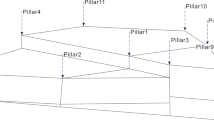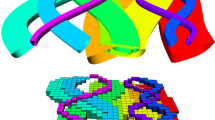Abstract
The development of a simulator for homogeneous reservoirs with application in producer wells (represented by a sink) and the aquifer analysis is obtained by combining the Boundary Element Method (BEM), the Isogeometric Formulation using NURBS (Non-Uniform Rational B-Spline) as shape functions, and also the Axisymmetric Formulation. The Isogeometric Formulation makes the discretization of geometric model (mesh generation), which is the step of numerical analysis that is more time-consuming for the engineer, be no longer necessary, since the same functions that describe the geometry also approximate the field variables in the BEM. In other words, the same discretization used in the geometric model, generated in CAD (Computer Aided Design) modeling programs, also is used by the BEM. The oil and water reservoirs, as simplified models for validation of the new mathematical methodology, can be fully represented by the analysis of a plane passing through the axis of rotational (axial) symmetry. The dimension of the problem is reduced from three to two dimensions: radial and axial directions only, and all variables in the circumferential direction are assumed to be constant. When the geometry and the problem variables are both axisymmetric, then the problem is considered fully axisymmetric. The isogeometric and axisymmetric formulations are coupled to obtain the well simulator for the single and double phase case, i.e., one or two incompressible fluids inside the reservoir. The determination of boundary conditions for the model, including the analysis of fluids interface movement, is also presented. The final code is a new tool for the analysis of gas/water coning phenomenon and quick drawdown problem in homogeneous reservoirs, as validation models. Validation of the results is carried out by comparing with others numerical methods and analytical results.










Similar content being viewed by others
Abbreviations
- \(\mathbf{A }\) :
-
Unknown variables vector
- A :
-
Cross-sectional area
- \(\mathbf{b }\) :
-
Unknown variables vector
- B :
-
Control points
- b :
-
Thickness
- c :
-
Multiplying constant
- C :
-
Curve function
- \(\mathbf{e }\) :
-
Unit normal vector
- \(\mathbf{E }\) :
-
Transformation matrix
- F :
-
Interface function
- g :
-
Gravity acceleration
- \(\mathbf{G }\) :
-
Matrix
- \(\mathbf{H }\) :
-
Matrix
- H :
-
Height
- K :
-
Hydraulic conductivity
- L :
-
Length
- m :
-
Parameter
- \(\mathbf{n }\) :
-
Normal vector
- n :
-
Porosity
- N :
-
Basis function
- p :
-
Pressure; Load point
- \(\mathbf{q }\) :
-
Apparent velocity vector
- q :
-
Volumetric flow rate per unit cross-sectional area
- Q :
-
Volumetric flow rate; Field point
- r :
-
Radial coordinate; Radius
- R :
-
Rational basis function
- \(\mathbf{s }\) :
-
Sink vector
- t :
-
Time; Curve parameter
- \(\mathbf{u }\) :
-
Real average velocity vector;
- u :
-
Knot vector values
- \(\mathbf{U }\) :
-
Knots vector
- \(\mathbf{x }\) :
-
Variable vector; Position vector
- \(\mathbf{V }\) :
-
Translation vector
- x :
-
Ordinate axis
- y :
-
Abscissa axis
- z :
-
Vertical and axial coordinate
- \(\alpha \) :
-
Specific mass ratio
- \(\beta \) :
-
Weighting factor
- \(\Gamma \) :
-
Boundary
- \(\delta \) :
-
Dirac delta
- \(\Delta \) :
-
Finite difference
- \(\nabla \) :
-
Mathematical operator
- \(\eta \) :
-
Free surface slope angle
- \(\theta \) :
-
Tangential direction
- \(\kappa \) :
-
Absolute permeability
- \(\lambda \) :
-
Interface height function
- \(\mu \) :
-
Fluid dynamic viscosity
- \(\rho \) :
-
Fluid specific mass
- \(\Phi \) :
-
Velocity potential (piezometric head)
- \(\omega \) :
-
Weight function
- axi :
-
Relative to the axial
- d :
-
Relative to the source point
- e :
-
Relative to the elliptic; relative to the external
- g :
-
Relative to the gas
- i :
-
Relative to the specific control point
- j :
-
Relative to the quantity of sink
- k :
-
Relative to the curve order
- m :
-
Relative to the time step
- o :
-
Relative to the oil
- p :
-
Relative to the pump
- s :
-
Relative to the sink
- t :
-
Relative to the top; relative to the total
- w :
-
Relative to the well; relative to the water
- x :
-
Relative to the arbitrary control point
- z :
-
Relative to the height of interface
- 2D :
-
Relative to the two-dimensional
- 3D :
-
Relative to the three-dimensional
- c :
-
Relative to the control point
References
Dake LP (1983) Fundamentals of Reservoir Engineering, vol 8, 1st edn. Elsevier, Amsterdam
Fortaleza ELF, Filho JOAL, Gontijo GSV, Albuquerque EL, Solimões RDP, Soares MM, Miranda MER, Abade GC (2019) Analytical, numerical and experimental study of gas coning on horizontal wells. J Braz Soc Mech Sci Eng 12:1783–1810
Ramsak M, Skerget L (2014) A highly efficient multidomain BEM for multimillion subdomains. Eng Anal Bound Elem 43:76–85
Bear J (1972) Dynamics of fluids in porous media. Elsevier, Amsterdam
Ligget JA, Liu PLF (1983) The boundary integral equation method for porous media flow. George Allen and Unwin, Crows Nest
Lin F (1996) NURBS in CAD and Computer Graphics, 1st edn. Springer, New York
Piegl L, Tiller W (1996) The NURBS book. Springer, Berlin
Rogers DF (2000) An introduction to NURBS: with historical perspective. Elsevier, Amsterdam
Farin GE (1999) NURBS for curve & surface design: from projective geometry to practical use. A K Peters/CRC Press, Boca Raton
Piegl L (1991) On nurbs: a survey. IEEE Comput Gr Appl 11(1):55–71
Lamousin H, Waggenspack N (1994) Nurbs-based free-form deformations. IEEE Comput Gr Appl 14(6):59–65
Hughes T, Reali A, Sangalli G (2010) Efficient quadrature for nurbs-based isogeometric analysis. Comput Methods Appl Mech Eng 199(5–8):301–313
Temizer I, Wriggers P, Hughes T (2011) Contact treatment in isogeometric analysis with nurbs. Comput Methods Appl Mech Eng 200(9–12):1100–1112
Nielsen PN, Gersborg AR, Gravesen J, Pedersen NL (2011) Discretizations in isogeometric analysis of Navier–Stokes flow. Comput Methods Appl Mech Eng 200(45):3242–3253
Bazilevs Y, Calo VM, Hughes TJR, Zhang Y (2008) Isogeometric fluid-structure interaction: theory, algorithms, and computations. Comput Mech 43(1):3–37
Bazilevs Y, Akkerman I (2010) Large eddy simulation of turbulent Taylor–Couette flow using isogeometric analysis and the residual-based variational multiscale method. J Comput Phys 229(9):3402–3414
Hughes TJR, Cottrell JA, Bazilevs Y (2005) Isogeometric analysis: Cad, finite elements, nurbs, exact geometry and mesh refinement. Comput Methods Appl Mech Eng 194:4135–4195
Cabral JJSP, Wrobel LC, Brebbia CA (1990) A bem formulation using b-splines: I-uniform blending functions. Eng Anal Bound Elem 7(3):136–144
Cabral JJSP, Wrobel LC, Brebbia CA (1991) A BEM formulation using b-splines: Ii-multiple knots and non-uniform blending functions. Eng Anal Bound Elem 8:51–55
Simpson RN, Bordas SPA, Trevelyan J, Rabczuk T (2012) A two-dimensional isogeometric boundary element method for elastostatic analysis. Comput Methods Appl Mech Eng 209:87–100
Simpson RN, Bordas SPA, Lian H, Trevelyan J (2013) An isogeometric boundary element method for elastostatic analysis: 2d implementation aspects. Comput Struct 118:2–12
Wang D, Zhang H (2014) A consistently coupled isogeometric-meshfree method. Comput Methods Appl Mech Eng 268:843–870
Shaw A, Roy D (2008) Nurbs-based parametric mesh-free methods. Comput Methods Appl Mech Eng 197(17):1541–1567
Kim HJ, Youn SK (2012) Spline-based meshfree method. Int J Numer Methods Eng 92(9):802–834
Campos LS, Albuquerque EL, Wrobel LC (2017) An aca accelerated isogeometric boundary element analysis of potential problems with non-uniform boundary conditions. Eng Anal Bound Elem 80:108–115
Lucas SK, Blake JR, Kucera A (1991) A boundary-integral method applied to water coning in oil reservoirs. J Aust Math Soc 32:261–283
Bakr AA (1986) The boundary integral equation method in axisymmetric stress analysis problems. Springer, Heidelberg
Becker AA (1992) The boundary element method in engineering: a complete course. McGraw-Hill, New York
Katsikadelis JT (1984) The boundary element method for engineers and scientists—theory and applications, 2nd edn. Springer, New York
Zhang H, Barray DA, Hocking GC (1999) Analysis of continuous and pulsed pumping of a phreatic aquifer. Adv Water Resour 22(6):623–632
Rafiezadeh K, Ataie-Ashtiani B (2014) Transient free-surface seepage in three-dimensional general anisotropic media by BEM. Eng Anal Bound Elem 46:51–66
Hall H (1955) An investigation of steady flow toward a gravity well. La Houille Blanche 10:8–35
Taylor G, Luthin J (1969) Computer methods for transient analysis of water-table aquifers. Water Resour Res 5:144–152
Cooley R (1983) Some new procedures for numerical solution of variably saturated flow problems. Water Resour Res 19:1271–1285
Ruiz JAM, Chen B, Trevelyan J, Gourgiotis PA, Albuquerque EL (2019) Enriched BEM for water coning. In: Proceedings of the UKBIM12 conference, Oxford, UK, pp 1–8
Author information
Authors and Affiliations
Corresponding author
Additional information
Technical Editor: Celso Kazuyuki Morooka.
Publisher's Note
Springer Nature remains neutral with regard to jurisdictional claims in published maps and institutional affiliations.
The Authors would like to acknowledge the Brazilian institutions: CNPq, CAPES, FINEP and MCT for supporting the present study.
Rights and permissions
About this article
Cite this article
Nascimento, L.G., Gontijo, G.S.V., Albuquerque, É.L. et al. A well simulator for homogeneous reservoirs based on formulations of the isogeometric boundary element method. J Braz. Soc. Mech. Sci. Eng. 43, 206 (2021). https://doi.org/10.1007/s40430-021-02924-7
Received:
Accepted:
Published:
DOI: https://doi.org/10.1007/s40430-021-02924-7




